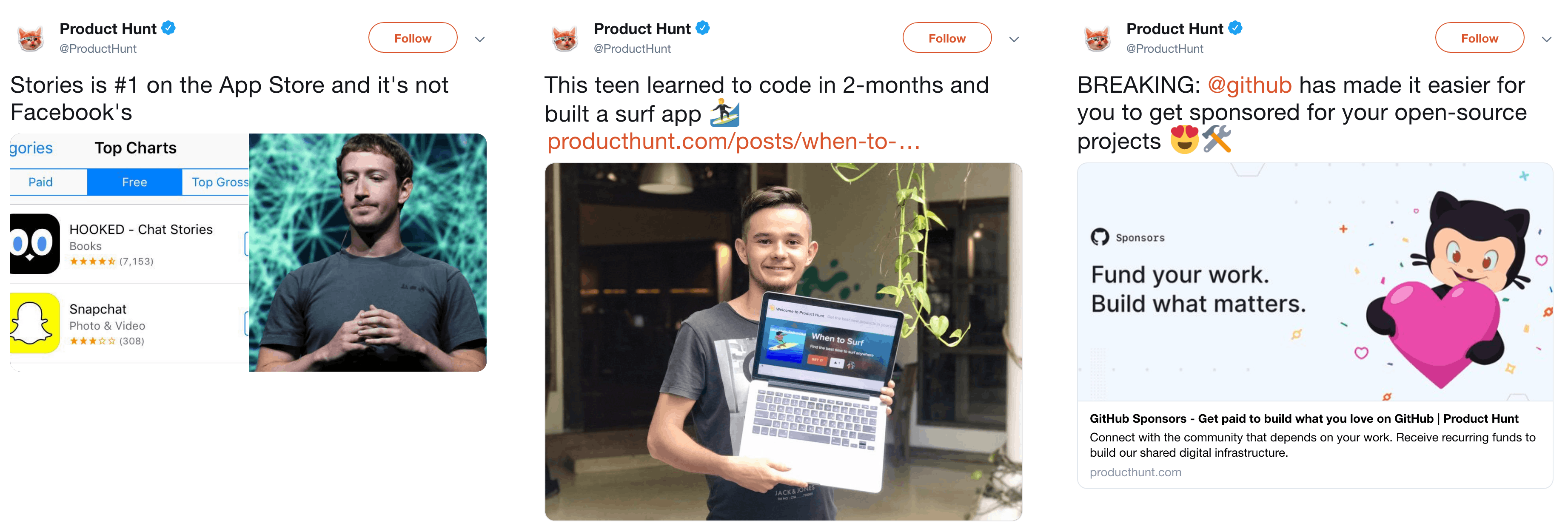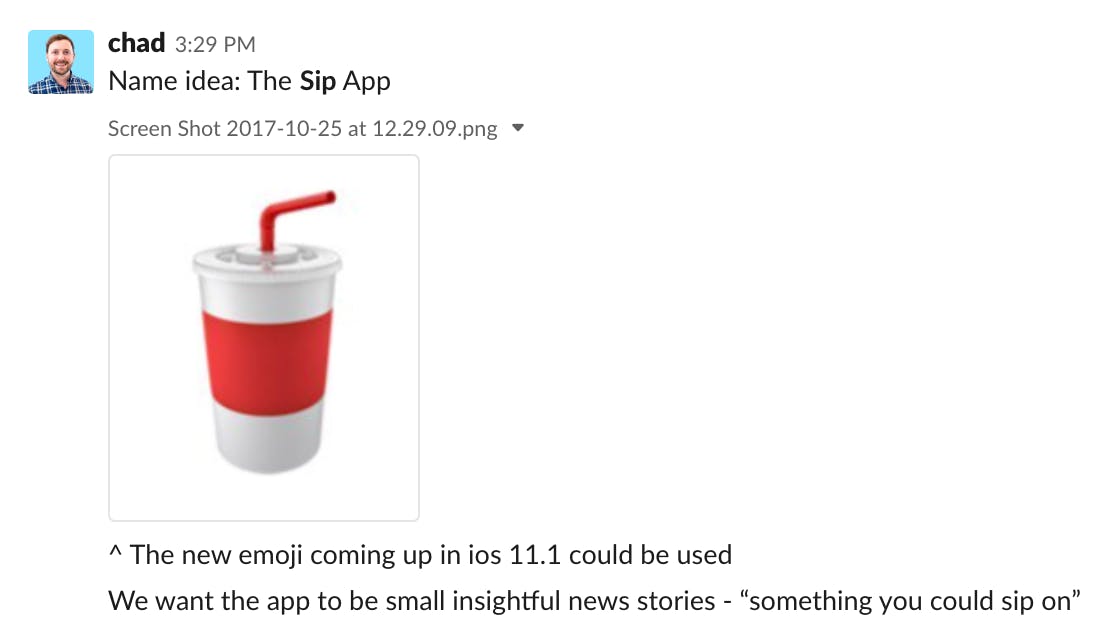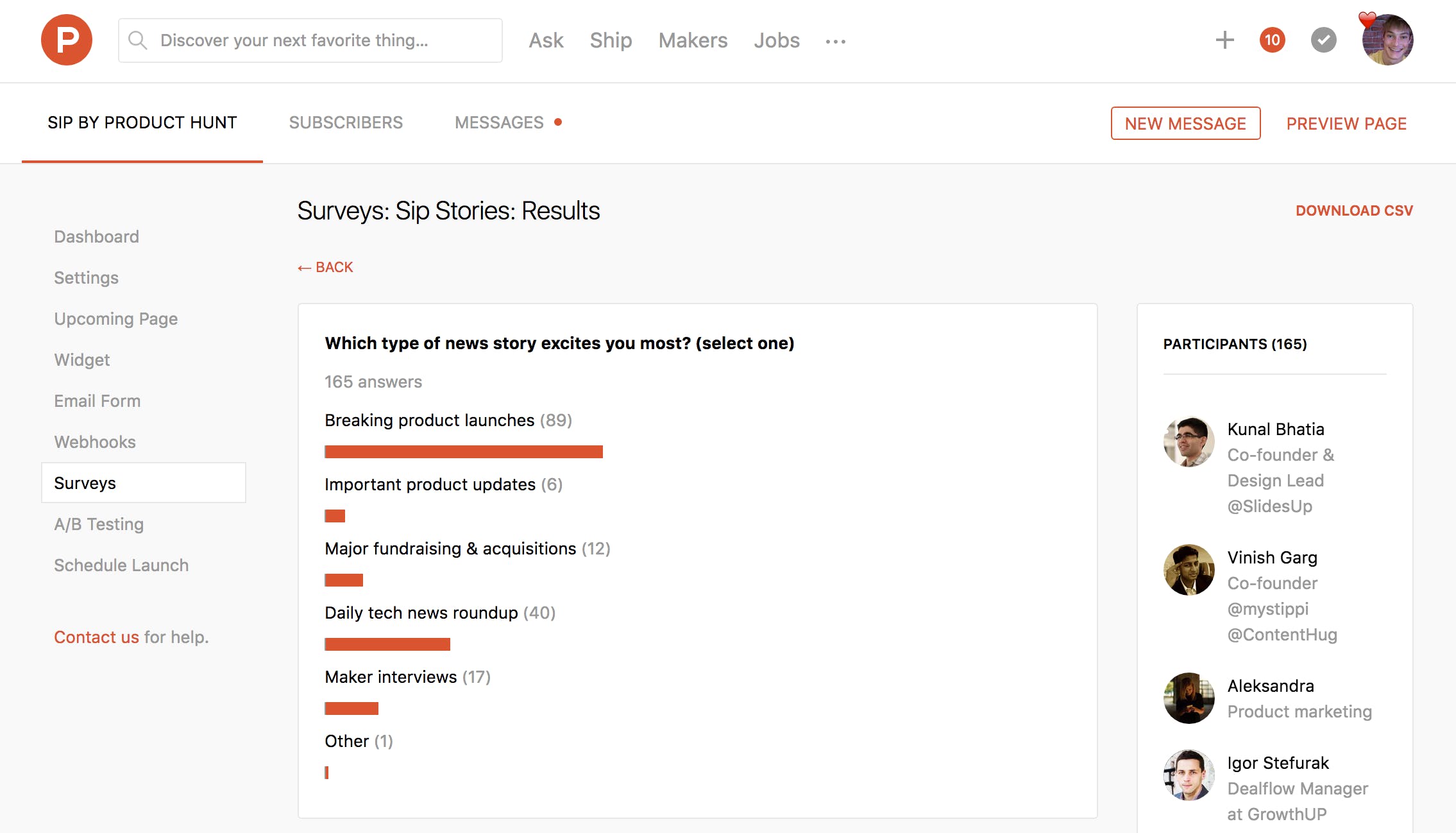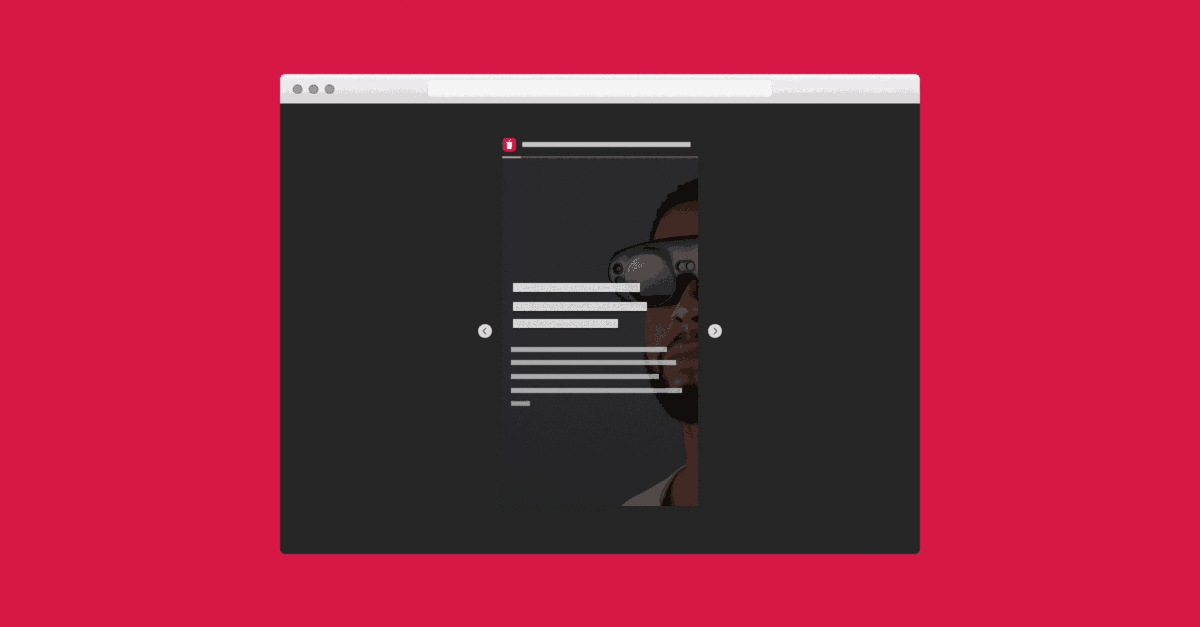Subscribe
Sign in
Sunsetting Sip: A Post Mortem

Share On
In January 2019, we quietly discontinued Sip. This is why it didn't work.
Many describe Product Hunt as the place to see what's next in tech. Every day startups and makers launch their latest creation on the site, introducing it to the world for the first time. Like everyone else, I wake up each morning curious, inspired, and sometimes surprised by what I find.
People come to Product Hunt to discover new things they wouldn't know to search for...because they didn't exist the day prior. And over the years we've noticed a pattern.
Launches that inspire the most engagement, tell a story. Products that tie into culturally relevant moments like this new startup from Game of Thrones’ Maisie Williams, viral surprises like Facebook-acquired tbh, and big releases from well-known companies like GitHub often attract the most interest.

We try to learn from the community and build for things they do (not just what they say). So, back in late 2017 we started exploring how we might deliver tech news and stories in our own unique way.
The idea
Initially, we thought about creating a new section of producthunt.com to surface articles, blog posts, videos, and other newsworthy items submitted by the community. The feed would be curated by upvotes and enriched with comments from the authors and creators, similar to what we see on the homepage. Here’s one of our design explorations:

But we had three big concerns that it:
- Felt derivative, lacking originality.
- Would result in duplicate content found on the homepage.
- Might complicate the UX and dilute Product Hunt's core focus: discovering new products and connecting with makers.
So, we scratched that approach and started exploring other ideas.
We knew timeliness was important, so building a solution inside a device that people carry with them nearly 100% of the day would be the most accessible way to deliver news and stories. We asked: What if we built a separate mobile app altogether? And what would we name it?
Enter: Sip.

We honestly didn't do any research behind the name. "Sip" felt right and we wanted to move quickly, so we ran with it.
Fun fact: I put maybe five minutes of thinking into the name "Product Hunt" when it first started as an email list years ago. 🤷♂️
We began building the initial mobile apps and backend to support them — in public.
It started with a landing page using Ship to start capturing interest, create a dialog with our audience, and survey the community to better understand their preferences. We learned that people were most interested in breaking product launches:

We decided the app would be dedicated to delivering the most important news, launches and stories once a day. We created a tappable UX similar to Snapchat/Insta/Facebook/Whatsapp Stories (I know, lol). We also wanted to avoid creating another app thirsty for attention, so we decided to deliver a daily summary of the top stories (to start).
As with many software projects, we underestimated how long the app would take to build by about 2x. But eventually we built something we felt was ready to share.
The launch
In February of 2018, we launched Sip on Product Hunt (of course).

The launch went well:
- It received 2,375 upvotes
- It became the #1 Product of the Day
- It reached #4 Product of the Month
Josh Constine from TechCrunch wrote about it: Product Hunt launches a no-spam tech news digest app Sip
So did Matthew Hughes from The Next Web: Product Hunt has a news app called Sip (and it’s a bit like Twitter Moments)
The community seemed to like it, too:

Every day at 5pm Pacific Time we delivered a quick summary of the most important tech news stories. We positioned Sip as a non-disruptive way to stay updated on what's happening with this single daily notification for a few reasons:
- It was a way to uniquely position Sip in a crowded market.
- Our audience is busy, productivity-focused professionals with a low tolerance for disruption.
- Batching stories once a day reduced the amount of (limited) time we had.
We were off to a good start. But starting is the easy part.
Actions over words
By July, we reached 9.4K unique monthly readers. This clearly wasn't meaningful enough for our business, so we started experimenting.
Rather than delivering a single notification summary each day, we started testing (silent, non-buzzing) notifications for breaking news stories in real-time. Engagement jumped by 3x overnight.
At launch everyone told us how much they appreciated the infrequent, non-disruptive, daily summaries. In reality, they wanted to learn about the news the moment it broke. Sip wasn't that useful for people if they've already caught up via their Twitter feed or over lunch with their teammates.
We made a permanent shift to deliver news as it was happening. Of course, that magnified the amount of work we had to do curating and summarizing 15-25 stories five days a week. This “little” project needed to reach several hundred thousands of people every week to justify the amount of work we put in.
Side note: From the beginning our vision for Sip was to be community driven but we knew the easiest and fastest way to test our assumptions and grow an initial audience was to do it ourselves.
Growing pains
From the beginning, we knew how hard it would be to get someone to download yet another app, let alone open it every day. We knew we could dramatically increase adoption by expanding Sip to the web, reducing the barrier to entry and making these stories more shareable. In August 2018 we did just that and (as you might assume) launched on Product Hunt after some internal beta testing.

Adoption grew dramatically. 10x more people were reading Sip stories every week. But the truth is, we cheated.
Our expansion to the web made Sip more accessible and achieved our goal of increasing the number of readers, but we did so by cannibalizing traffic from other parts of our platform. We promoted Sip stories in the Product Hunt newsletter, homepage, and social channels, reducing attention in other areas of the business.
Furthermore, web users were far less sticky than mobile users, as you might expect. While our unique user count grew to well over 100K monthly readers, it didn't lead to sustainable adoption and retention on the web.
Shutting down Sip
In January 2019, we quietly discontinued Sip.
Why didn’t it work? A few takeaways:
1. Distribution is key and needs to be built into the product.
The most successful consumer products often have distribution built into the product itself. For example, Product Hunt's homepage has a nice flywheel effect: When makers and startups launch, they drive traffic to the site and some of those visitors end up launching their own product on the site in the future. And the cycle continues.
Sip was a single player experience and lacked an engagement loop that would encourage users to invite other users.
This point is even more important today as consumers face fatigue and makers face increasing competition as the cost to build continues to drop. Distribution should be considered on day one and built into the product.
2. Be honest with your metrics and look at the macro.
As with every project we work on, we created a dashboard in Periscope to report and visualize KPIs. In isolation, our Sip dashboard showed some healthy signs of adoption. But when zooming out it was clear that other metrics were negatively affected.
We were shifting traffic and attention from one part of Product Hunt to another. Instead of focusing the daily newsletter or social channels on new launches on the site, we pointed the community to Sip. The result: fewer people explored the homepage and upvoted products.
3. It always takes longer than expected.
People tend to underestimate the amount of time it takes to build something. It's called planning fallacy.
We should have been more realistic on the amount of effort required to build and manage Sip on a daily basis.
We also made the classic startup mistake of not setting deadlines, leading to lingering releases and delays. Deadlines are a healthy forcing function for decisions and trade offs. Constraints force creativity and prioritization.
Next up
Whether you’re a solo maker or a multi-billion dollar company (like this), it’s always difficult to build something new that people want. With all the data and intuition, you'll never really know if it works until you try. The key is making smart decisions and iterating quickly.
We've taken these learnings from Sip to heart as we continue to build new things at Product Hunt. And of course, we're cooking up something new. It will live on its own site, under a different brand.
We'll share more details soon but in the meantime, follow @YourStacks on Twitter for an early preview. 🥞😉
*Header photo credit: Matt Botsford.
Comments (20)
Anton McCarthy@antonmccarthy
Good to try but I was somewhat surprised to see PH pursuing this concept, seeing as there are a million different existing ways people can get news - Twitter, tech blogs, email digests, FB, etc. It's one of those cases too of focusing on your core proposition and the reason people come to your site every day - why dilute that, as Ryan came to realise.
Share
Thanks for sharing the details!
Let’s be real. On October 18th 2018 I emailed you about the lack of updates. You never replied to my email. Then on December 20th 2018 you stopped posting new stories. I sent a second email on Jan 1. You said your team was on vacation. Seems like you gave up long before Jan 2019. I deleted the app around Jan 23, 2019.
Thanks for sharing @rrhoover ! I love the product design of Sip and strongly believe that's the way news is going to be consumed over the next few years. The format itself is so powerful. Sip was an app I would open every morning sitting in the toilet. However, I spent (way) more time in the toilet than I was allowed to on Sip.
What was missing?
- More stories. I always had a feeling that there was more news out there which Sip wasn't feeding me.
- Lack of viral news. It was all too nice. Single user mode maybe was to consume news that you feel guilty to read?
- Share experience. Very basic link share - each story was a goldmine to get users to share. Direct image share, maybe?
I could go on and on as I have spent a lot of time discussing why this is an ideal format to share and consume 360-degree news stories. Hope we see a comeback and I would love to contribute!
SlidesUp API
Would love to tell this + the @YourStacks story on @Take1Design as part of the stories we launch with in late August. What do you think @rrhoover?
Certainly would help the multiplayer flywheel effect!
More stories

Mathew Hardy · How To · 3 min read
How to Detect AI Content with Keystroke Tracking

Sanjana Friedman · Opinions · 9 min read
The Case for Supabase

Vaibhav Gupta · Opinions · 10 min read
3.5 Years, 12 Hard Pivots, Still Not Dead
Kyle Corbitt · How To · 5 min read
A Founder’s Guide to AI Fine-Tuning

Chris Bakke · How To · 6 min read
A Better Way to Get Your First 10 B2B Customers
